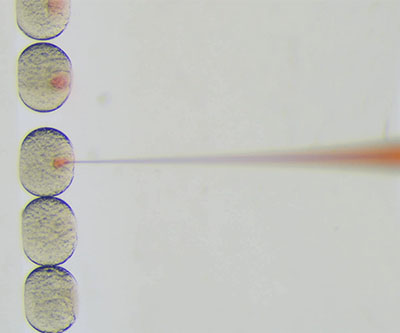
Injection of transparent zebrafish embryos with messenger RNA that introduces light-sensitive proteins.
Credit: Allison Saul, Rogers Lab, NICHD
Signaling pathways allow cells to respond to their environment and orchestrate fundamental biological processes, including early development. Experimental methods to manipulate cell signaling help scientists understand how signaling is interpreted in different contexts.
- Recent work by the Rogers Lab describes application of a technique called optogenetics that enables researchers to use light to activate cell signaling in a fast, reversible, and tunable manner.
- The researchers’ approach allowed them to manipulate cell signaling crucial for embryonic development in zebrafish. The approach involves injecting messenger RNA that introduces light-sensitive proteins into the embryos of zebrafish, a model organism for studying early development. The targeted signaling pathways can then be controlled in subsequent experiments by exposing the embryos, which are transparent and develop outside of the mother, to light.
- The investigators developed a protocol to guide other scientists in applying this optogenetic method to their research. The protocol includes instructions for a control assay to determine appropriate experimental conditions and an experiment to directly assess signaling.
- The protocol may help researchers establish a pipeline for using optogenetic tools in early zebrafish embryos, providing a powerful platform to investigate the roles of signaling in development and health.
NICHD authors of the paper include Allison J. Saul and Catherine E. Rogers (co-first authors) and Katherine W. Rogers.
Learn more about the Aquatic Models of Human Development group: https://www.nichd.nih.gov/about/org/dir/affinity-groups/AMHD
 BACK TO TOP
BACK TO TOP